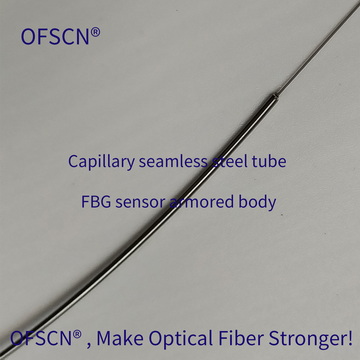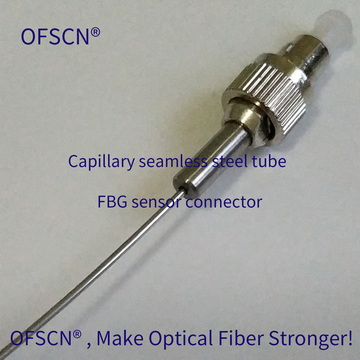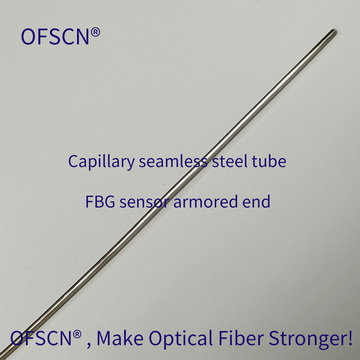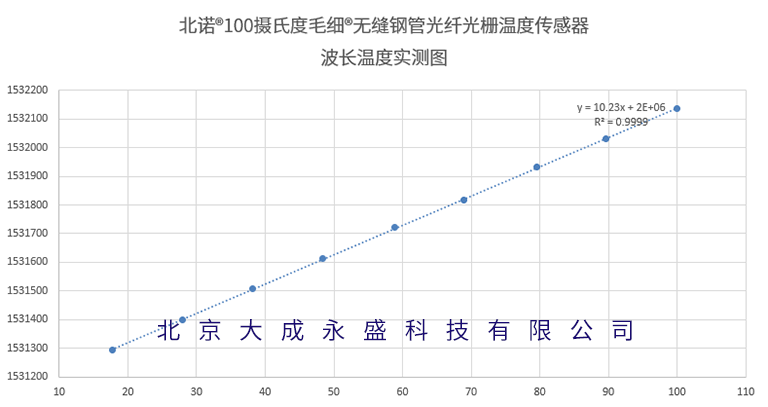OFSCN® 100-degree Celsius capillary seamless steel tube fiber bragg grating (FBG) temperature sensors (FBG thermometers) produced by DCYS undergo calibration during the manufacturing process. They are accompanied by the basic temperature coefficient (also known as calibration coefficient or calibration function) of the fiber bragg grating sensor. The following is a brief description of the calibration of this product:
Table of Contents:
| 1. Product Structure of 100°C Fiber Bragg Grating Temperature Sensor |
1. Product Structure of OFSCN® 100°C Capillary Seamless Steel Tube Fiber Bragg Grating Temperature Sensor:
OFSCN® 100°C Capillary Seamless Steel Tube Fiber Bragg Grating Temperature Sensors (FBG Thermometers) are protected by a full-metal encapsulation to safeguard the fiber bragg grating (FBG). The standard product has a diameter of 0.9 millimeters, and the overall structure and the product itself are shown in Figure 1, 2, and 3:
 |
|
|
Figure 1 |
|
 |
 |
|
Figure 2 |
Figure 3 |
The connectors and tail ends are illustrated in Figures 4 and 5:
 |
 |
|
Figure 4 |
Figure 5 |
Due to the unique stainless steel seamless tube patent packaging technology and our special processing techniques applied to the OFSCN® 100-degree Celsius capillary seamless steel tube fiber bragg grating temperature sensor (FBG thermometer), it possesses the following features: high sensitivity, fast thermal conduction, good accuracy, small size, light weight, high tensile and compressive strength, high temperature resistance, waterproof and moisture-proof properties, non-flammable, and corrosion resistance.
2. Factory Test Report for OFSCN® 100°C Capillay Seamless Steel Tube Fiber Bragg Grating Temperature Sensor - Calibration Coefficient Graph:
High accuracy is the lifeline of DCYS's products, and this characteristic is verified through the test reports of each sensor we produce, as shown in the following figure:
 |
|
Figure 6 |
Figure 6 above shows the measured chart of the calibration coefficient (calibration function) of an actual sold OFSCN® 100-degree Celsius capillary seamless steel tube fiber bragg grating temperature sensor. The curve illustrates the correlation between the wavelength variation of the sensor and temperature change, with a test range from room temperature to 100 degrees Celsius. Since this sensor can be used up to a maximum of 120 degrees Celsius, if requested by the customer, we can also provide calibration for temperatures ranging from room temperature to 120 degrees Celsius, with a calibration temperature interval of approximately 10 degrees Celsius.
Unlike the legend, the official factory report will also provide specific wavelength values and temperature values. For general temperature measurement requirements, this calibration coefficient can be directly used.
Each OFSCN® 100-degree Celsius capillary seamless steel tube fiber bragg grating temperature sensor (FBG thermometer) has a unique calibration coefficient (calibration function), which is tested and recorded by the Quality Inspection Department of DCYS, and can be accessed by customers at any time on the company's official website. In our experience, the R-squared value of the polynomial equation for the calibration function can reach 0.9995 or higher.
Our philosophy is: "OFSCN®, Make Optical Fiber Stronger!"
